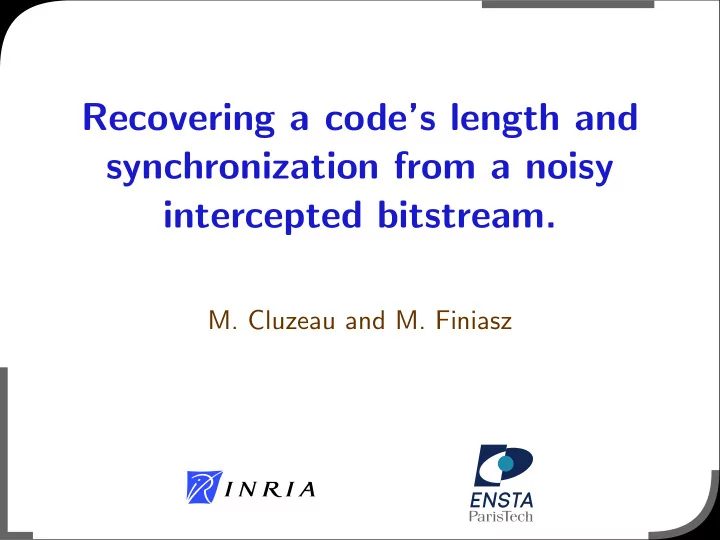

Recovering a code’s length and synchronization from a noisy intercepted bitstream. M. Cluzeau and M. Finiasz
Overview of the problem Source Recipient Compression Decompression Encryption Decryption Encoding Decoding Noisy�channel Encoded�message Interception ◮ We intercept a noisy bitstream and want to recover the page 1/11 (encrypted) information.
Overview of the problem ◮ Most of the time, coding schemes are standardized ⊲ no need for code reconstruction. ◮ Yet, “some people” are interested in this: ⊲ not many public works on this topic, ⊲ many interesting problems arise, depending on the type of code we focus on. ◮ Here we focus on linear block codes requiring to: ⊲ find the block length, ⊲ find a generator/parity check matrix, ⊲ find an efficient decoder, page 2/11 � we do not address this problem here.
Overview of the problem The case of linear block codes s n 010010110100001011101010010100101110... ◮ The only thing we have is a noisy bitstream: ⊲ we need to find s 0 and n 0 the synchronization and length of the code. ◮ For very short codes of small dimension various tech- niques can give us some hint on n , ⊲ none of them work for real life codes... page 3/11 � we have to test each choice of s and n .
In the absence of noise The easy case... ◮ For given s and n build the matrix G of “codewords” ⊲ if n = n 0 and s = s 0 it has minimal rank k , ⊲ if n = n 0 and s � = s 0 it has rank min( k + | s − s 0 | , n ) , ⊲ if n � = n 0 it has rank n . n s s - 0 n n - 0 M page 4/11
In the absence of noise The easy case... ◮ For given s and n build the matrix G of “codewords” ⊲ if n = n 0 and s = s 0 it has minimal rank k , ⊲ if n = n 0 and s � = s 0 it has rank min( k + | s − s 0 | , n ) , ⊲ if n � = n 0 it has rank n . ◮ Very efficient to guess n 0 and then s 0 , � only for very low noise levels τ ≪ 1 n . ◮ For higher noises the rank is always n ... page 4/11
In the presence of noise Using words of the dual ◮ If n and s are correct, a word of the dual of the target code multiplied by G should have low weight, ⊲ suppose we have such a dual word of low weight w . 1 − (1 − 2 ¿ ) w M Probability M 2 2 page 5/11 Product�weight
In the presence of noise Using words of the dual ◮ If a word following the green distribution is found, n = n 0 ⊲ and s − s 0 is probably small. 1 − (1 − 2 ¿ ) w M Probability M 2 2 page 5/11 Product�weight
The algorithm we propose ◮ We need to exhaustively search through the possible s and n . ◮ Successively go through the possible values of n ⊲ for each length “test” several synchronizations s � different possible heuristics. ◮ Testing a pair ( n, s ) consists in searching for a dual word following the green distribution: ⊲ exhaustive search of words of given weight page 6/11 ⊲ using Valembois’ algorithm.
Exhaustive search of given weight dual words ◮ We look for a dual word of length n and weight w . ◮ We can find all such dual words using: ⊲ straight-forward exhaustive search � O ( n w ) time and 0(1) memory. ⊲ the birthday algorithm w w � O ( n 2 ) time and O ( n 2 ) memory. ⊲ the Chose-Joux-Mitton algorithm [Eurocrypt 2002] w 2 ) time and O ( n ⌈ w 4 ⌉ ) memory. � O ( n ◮ Very efficient for codes with very low weight dual words page 7/11 � typically LDPC codes.
Valembois’ algorithm n 1 ⊲ Based on the Canteaut-Chabaud 0 weight�2 p decoding algorithm, ⊲ does not focus only on low 0 weight dual words, 1 M ⊲ small memory requirements. l 0 weight < T -2 p ◮ Very efficient for low noise levels, page 8/11 � tolerates higher noise levels for very short codes.
Practical results Random linear codes ◮ Codes of rate 1 2 : ⊲ no low weight dual words, ⊲ for our problem: among the difficult cases. ◮ Dual words found in 10000 iterations of Valembois’ algorithm (less than a second). τ ❜❜❜❜❜❜❜ 0.001 0.002 0.005 0.01 0.02 0.05 n 32 14637 27081 42570 42913 19464 210 64 ∞ ∞ ∞ 1172189 6310 0 128 ∞ ∞ ∞ 2992 0 0 page 9/11 256 ∞ ∞ 0 0 0 0
Practical results LDPC codes ◮ LDPC codes of rate 1 2 and weight 6 parity checks, ⊲ find words for lengths up to 10000 with 2GB memory. ◮ For an LDPC of length 1000 in 50 iterations ( ∼ 2 min.) expected words words expected total τ per iteration found words found 0.01 478 41 492 0.02 251 7.5 266 0.03 84 1.5 70 0.04 15 0.33 16 0.05 6 0.08 3.9 page 10/11 0.06 1 0.02 1.0
Conclusion ◮ We can find the length/synchronization of a code by using reconstruction techniques, ⊲ easier for codes with low weight dual words � LDPC ⊲ not very satisfying for random codes. ◮ For an unknown code, both techniques should be tried ⊲ for very low noise levels, Valembois’ algorithm is faster, even for long LDPC codes. ◮ For other kind of codes: ⊲ convolutional codes [Cˆ ote,Sendrier - ISIT09] page 11/11 ⊲ turbocodes � we are working on it...
Recommend
More recommend